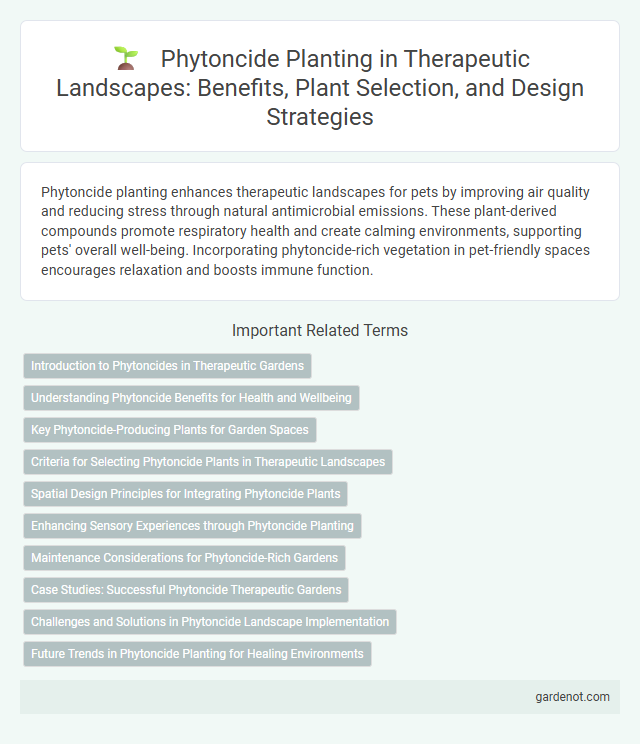Phytoncide planting enhances therapeutic landscapes for pets by improving air quality and reducing stress through natural antimicrobial emissions. These plant-derived compounds promote respiratory health and create calming environments, supporting pets' overall well-being. Incorporating phytoncide-rich vegetation in pet-friendly spaces encourages relaxation and boosts immune function.
Introduction to Phytoncides in Therapeutic Gardens
Phytoncides are natural antimicrobial compounds emitted by plants, playing a crucial role in therapeutic gardens by enhancing air quality and promoting mental well-being. Incorporating phytoncide-rich species such as conifers, pines, and eucalyptus into landscape design supports stress reduction and immune system strengthening through biophilic interactions. Research shows that exposure to phytoncides can decrease cortisol levels and improve overall mood, making them essential elements in creating effective healing environments.
Understanding Phytoncide Benefits for Health and Wellbeing
Phytoncide planting enhances therapeutic landscapes by releasing natural antimicrobial compounds from trees, which improve air quality and reduce stress levels in humans. Exposure to phytoncides has been scientifically linked to increased immune function, lower blood pressure, and enhanced mood, contributing significantly to overall health and wellbeing. Integrating phytoncide-rich vegetation into urban green spaces supports mental restoration and physical health through the promotion of biophilic interactions.
Key Phytoncide-Producing Plants for Garden Spaces
Key phytoncide-producing plants for garden spaces include conifers such as pines (Pinus spp.) and cedars (Cedrus spp.), known for emitting high levels of antimicrobial volatile organic compounds. Broadleaf species like eucalyptus (Eucalyptus globulus) and rosemary (Rosmarinus officinalis) also release potent phytoncides that enhance air quality and promote psychological well-being. Incorporating these plants into therapeutic landscapes supports natural pathogen reduction and stress alleviation through bioactive plant emissions.
Criteria for Selecting Phytoncide Plants in Therapeutic Landscapes
Selecting phytoncide plants for therapeutic landscapes requires evaluating species with high essential oil emissions known for antimicrobial and stress-reducing properties, such as conifers like pine and cedar. The plants should thrive in the local climate and soil conditions to ensure sustainable growth and consistent phytoncide release throughout the year. Accessibility and safety for users are critical, prioritizing non-toxic, low-allergen species that contribute to a calming environment.
Spatial Design Principles for Integrating Phytoncide Plants
Strategic spatial design for integrating phytoncide plants emphasizes creating multi-layered plant arrangements that maximize air purification and stress reduction benefits. Incorporating diverse phytoncide species such as pine, cedar, and cypress in clustered formations enhances volatile organic compound dispersion and promotes immersive therapeutic environments. Optimizing pathways and seating areas within these green zones facilitates prolonged exposure to phytoncide emissions, improving overall mental health and well-being.
Enhancing Sensory Experiences through Phytoncide Planting
Phytoncide planting enhances sensory experiences by releasing natural antimicrobial volatile organic compounds from plants like pine, cedar, and cypress, which improve air quality and promote relaxation. Exposure to phytoncides has been scientifically linked to reduced stress hormone levels, increased parasympathetic nervous activity, and improved mood states. Integrating phytoncide-emitting vegetation in therapeutic landscapes creates immersive environments that support mental well-being and sensory restoration.
Maintenance Considerations for Phytoncide-Rich Gardens
Maintaining phytoncide-rich gardens involves regular pruning of trees and shrubs such as Hinoki cypress and pine species to sustain optimal essential oil production. Soil quality management through organic mulching and balanced fertilization enhances plant health and maximizes phytoncide emissions. Monitoring pest populations and implementing integrated pest management ensures a sustainable therapeutic landscape environment.
Case Studies: Successful Phytoncide Therapeutic Gardens
Case studies of successful phytoncide therapeutic gardens highlight the measurable reduction in stress hormones and improved immune function among visitors. Research in Japan's Shinrin-yoku parks demonstrates enhanced mood regulation and cardiovascular health linked to terpene-rich plantings. Urban therapeutic landscapes incorporating cedar, cypress, and pine trees show significant potential in promoting mental well-being through natural phytoncide exposure.
Challenges and Solutions in Phytoncide Landscape Implementation
Phytoncide landscape implementation faces challenges such as selecting appropriate plant species with high phytoncide emission, ensuring soil quality, and maintaining optimal microclimate conditions for maximum therapeutic benefits. Solutions include integrated planning with native phytoncide-rich plants like pines and cypresses, employing soil amendments to enhance microbial activity, and designing irrigation systems to sustain plant health and phytoncide release. Monitoring tools such as air quality sensors and phytochemical analysis guide adaptive management for effective therapeutic landscape performance.
Future Trends in Phytoncide Planting for Healing Environments
Future trends in phytoncide planting emphasize integrating a diverse range of aromatic trees and shrubs known for their natural antimicrobial compounds, such as Japanese cypress and pine, to enhance therapeutic landscapes. Advances in landscape architecture prioritize the strategic placement of phytoncide-emitting plants to maximize air quality improvement and stress reduction benefits in urban healing environments. Emerging research supports the development of sensor-based monitoring systems that optimize phytoncide levels, tailoring green spaces for personalized health outcomes.
Phytoncide planting Infographic

 gardenot.com
gardenot.com